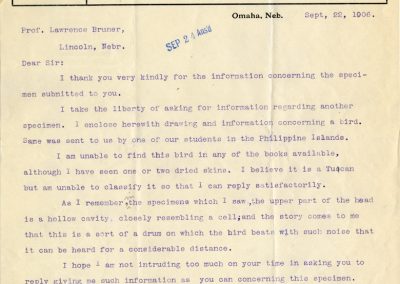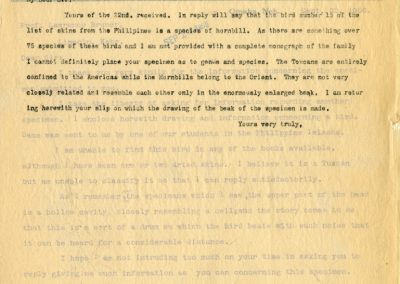Great Nebraska
Naturalists and ScientistsNebraska Ornithologists’ Union
Letters, 1906, September
1906, Sept. 22
A. S. Carpenter, President J. W. Elwood, Manager
The Northwestern School of Taxidermy Incorporated Capitalization $10,000. Fully Paid.
Taxidermy Taught by Correspondence . . . Dealers in Naturalists’ Books and Supplies . . .
Omaha, Neb. Sept, 22, 1906. Prof. Lawrence Bruner, Lincoln, Nebr. SEP 24 Ans’d
Dear Sir: I thank you very kindly for the information concerning the specimen submitted to you. I take the liberty of asking for information regarding another specimen. I enclose herewith drawing and information concerning a bird. Same was sent to us by one of our students in the Philippine Islands. I am unable to find this bird in any of the books available, although I have seen one or two dried skins. I believe it is a Tucan but am unable to classify it so that I can reply satisfactorily, As I remember, in the specimens which I saw, the upper part of the head is a hollow cavity, closely resembling a cell; and the story comes to me that this is a sort of a drum on which the bird beats with such noise that it can be heard for a considerable distance. I hope that I am not intruding too much on your time in asking you to reply giving me such information as you can concerning this specimen. Thanking you in advance, I am Very respectfully yours, J. W. Elwood Mgr. Dic. R.W. – E.
Hornbill About 75 species – Africa, India & Australasia north of Australia
1906, Sept. 24
Sept. 24th, 1906. Mr. J. W. Elwood, Omaha, Nebr.
My Dear Sir:- Yours of the 22nd. received. In reply will say that the bird number 15 of the list of skins from the Philipines is a species of hornbill. As there are something over 75 species of these birds and I am not provided with a complete monograph of the family I cannot definitely place your specimen as to genus and species. The Toucans are entirely confined to the Americas while the Hornbills belong to the Orient. They are not very closely related and resemble each other only in the enormously enlarged beak. I am returning herewith your slip on which the drawing of the beak of the specimen is made. Yours very truly,

